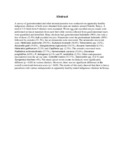| dc.description.abstract | A survey of gastrointestinal and other internal parasites was conducted on apparently healthy
indigenous chickens of both sexes obtained from open-air markets around Nairobi, Kenya. A total of
131 birds from 9 districts were examined. Worm egg and coccidial oocyst counts were performed on
faecal materials from each bird while worms collected from gastrointestinal tracts were quantified and
identified. Many chickens had gastrointestinal helminths (90%), but only a few of these (13.9%) had
coccidial oocysts. Nematodes were the predominant helminths (89%) followed by cestodes (51.5%),
but no trematodes were recovered. The nematodes recovered were: Heterakis isolonche (59.5%),
Subulura brumpti (36.0%) Tetrameres spp. (32%), Ascaridia galli (19.8%), Gongylonema ingluvicola
(19.1%), Acuaria hamulosa (6.1%), Heterakis gallinarum (5.3%) and Capillaria spp. (2.3%). The
cestodes recovered were: Raillietina echinobothrida (37.7%), Hymenolepis carioca (33.6%), Davainea
proglottina (6.9%), R. tetragona (6.1%) and R. cesticillus (2.3%). Other endoparasites encountered
were the air-sac mite, Cytodite nudus (15.3 %), Sacocystis spp. (5.6 %) and Syngamus trachea (4%).
The mean caecal worm counts in chickens were significantly different (p < 0.05) in various districts.
However, there was no significant difference in the overall worm loads between sexes (p > 0.05). The
results of this study showed that there is heavy parasitism with various endoparasites in apparently
healthy traded indigenous chickens in Kenya. | en_US |

